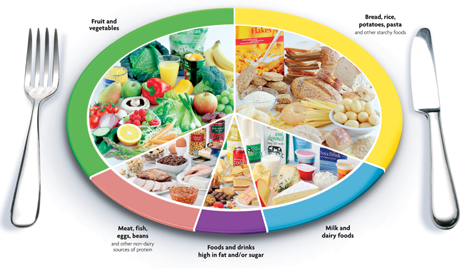![]()
![]()
![]()
![]()

![]()
![]()
![]()
![]()
Bread, rice, potatoes, pasta and other starchy Foods
Meals should be based on starchy foods, which includes pasta, rice, oats, cous cous, bread and potatoes. It is important to base meals on these foods as they are low in fat and a good source of energy. The carbohydrate in starchy foods is needed by muscles and our brain to function most effectively.
Starchy foods also contain soluble fibre. Soluble fibre increases the feeling of being full and causes energy to be released more gradually. A gradual release of energy and a full stomach means you are less likely to snack on high fat foods.
Starchy foods promote a healthy digestive system. The soluble fibre is an important prebiotic meaning it supports growth and activity of good bacteria in the gut. The presence of prebiotic bacteria increases probiotic bacteria. It also reduces the risk of cancers of the digestive system and is protective against heart disease.
Avoid carbohydrates that have been refined such as instant mash potato ?? as these increase the risk of diabetes.
Fruit and Vegetables
Fruit and vegetables should also contribute to the same amount as Starchy Foods. These are protective against heart disease and cancers of the digestive system because they too contain soluble fibre (as explained under Starchy Foods).
The equivalent amount of fruit and vegetables that you should eat daily in comparison with the Eatwell plate is five portions a day. Eating five portions of fruit and vegetables a day prevents against some cancers because they contain protective nutrients. These are known as antioxidants and phytochemicals.
Fruit and vegetables support a low fat diet because the can be eaten as a snack and are low in fat. They also contain a mineral, Potassium which also makes tham a ‘bone-friendly’ snack because potassium is protective for bones.
Milk and dairy foods
These foods should be eaten in quantities of 2-3 portions a day. This could be milk with your cereal, a yoghurt for a mid-morning snack and a portion of cheese as part of your main meal at lunch. It is important to eat these foods as they are a great source of calcium, which is essential for bone growth, strength and development.
Food and drinks high in fat and/or sugar
These foods contain a lot of energy in a small amount so it is easy to take in more energy than we need from eating these types of foods without realising. Eating too many of these foods will lead to weight gain, causing us to become overweight or obese.
Those high in fat are normally ‘bad’ fats which increase the risk of heart attacks and strokes because they cause a build up of cholesterol in our arteries.
Food and drinks are high in sugar increase the risk of tooth decay. A large intake of sugar in one sitting can be followed in a drop in the level of sugar in our blood which can make us feel lethargic and crave more high sugar foods to give us energy which can lead to increased intakes of foods high in sugar and fat. Consistent bursts of sugar increases the risk of type II diabetes.
These foods should be eaten in small amounts and only eaten occasionally. Maybe as a treat
Meat, Fish, Eggs, Beans and other non-dairy sources of protein.
Our diets should include of 3 portions of these non-dairy sources of protein every day. Protein
is essential for building and repairing our muscles as well as lots of bodily functions. Over the week at least two of these portions should be fish, at least one of these fish portions should be oily fish, such as mackerel, salmon or sardines. Oily fish contains omega -3 which is protective against heart disease because it is a ‘good’ fat and lowers bad cholesterol in the blood.
The basis of the eatwell plate remains across the whole population. It is the portion sizes that will differ to meet the needs of an individual based on their age, gender, height, weight and how active they are.
Your nutrient guide – useful to take shopping!
The amount of nutrients is per 100grams.
Remember that a portion may be more or less than 100g.
LOW |
MEDIUM |
HIGH |
|
| Sugar | 5g and below | Between 5g and 15g | Over 15g |
Fat |
3g and below |
Between 3g and 20g |
Over 20g |
Saturated fat |
1.5g and below |
Between 1.5g and 5g |
Over 5g |
Salt |
0.3g and below |
Between 0.3 and 1.5g |
Over 1.5g |
HEALTHY EATING
Top wise tips:
- Base meals on starchy foods
- Eat fatty foods in moderation
- Aim to eat 5 fruit and vegetables a day
- Have 2 portions of fish a week, one of which should be oily fish such as salmon
- Have 2-3 portions of dairy foods a day
- Grill and bake instead of fry
- Cut fat off meat and remove skin
Home Page | About Wise Nutrition | Your Mission | Contact
Healthy Eating | Weight Control | Sport Nutrition | Vitamins, Minerals & Trace Elements

Healthy Eating
Healthy Eating should be based on a balanced diet to ensure that you get all the nutrients you need to give you energy, protect against some cancers and heart disease as well as have healthy skin, hair, eyes, bones, blood, nervous system and immune system.
A balanced diet should be based on the Eatwell plate devised by the Food Standards Agency. The Eatwell plate is divided into five sections.Each section represents the amount of that type of food that we should eat a day.

![]()
![]()
![]()
![]()

![]()
![]()
![]()
![]()
![]()
![]()
![]()
![]()

![]()
![]()
![]()
![]()